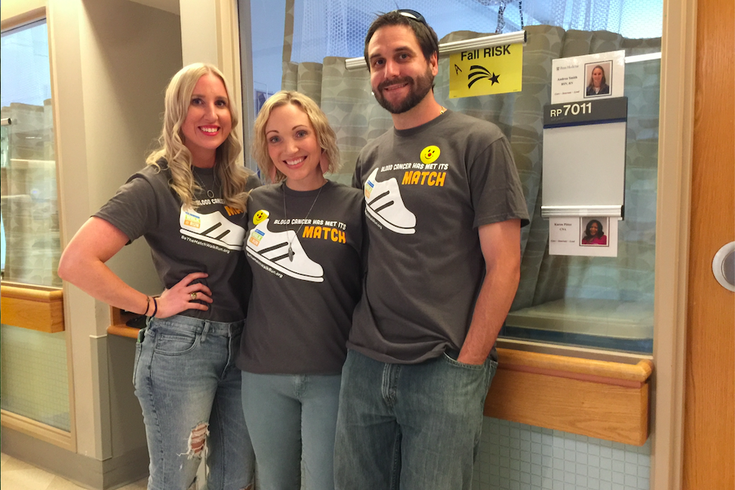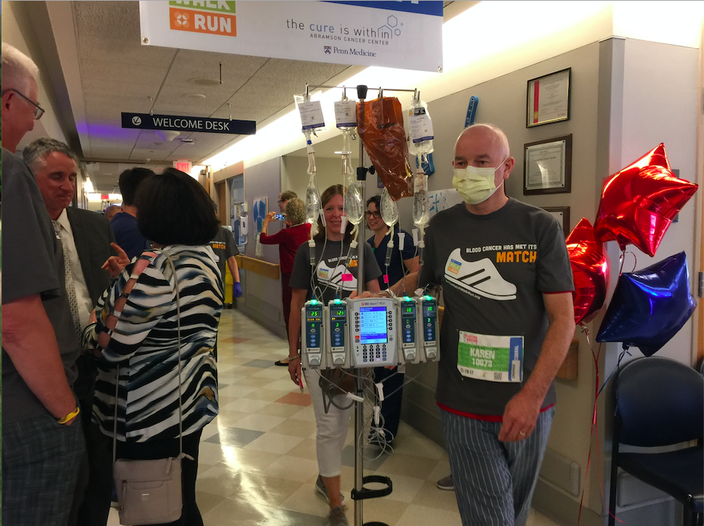
May 23, 2019
 Brian Hickey/PhillyVoice
Brian Hickey/PhillyVoice
Jenna Lawson (center), her husband Eric and nurse Brittany Muszynski outside the Hospital of University of Pennsylvania room where Jenna stayed before and after the stem-cell transplant which helped send her Acute Myeloid Leukemia into remission in 2016.
Jenna Lawson discovered a lump in her breast when she was 33 years old. Soon, the Harrisburg woman would learn she’d been diagnosed with breast cancer.
That alarming news – delivered in February 2013 – left the married mother of a one-year-old daughter undergoing a mastectomy, four-and-a-half months of chemotherapy, six weeks of radiation and exploring clinical trials at the Penn State Milton S. Hershey Medical Center.
Lawson handled the treatments so well that she was able “to pick my life up and move on afterwards,” but any comfort level would be short-lived.
“I was always worried about the cancer coming back,” she said. “But not in the way it did.”
The way it came back explained why she was speaking Wednesday morning to some 100 people on the seventh floor of the Rhoads building at the Hospital of the University of Pennsylvania.
It was time for the "Be The Match Walk/Run," an opportunity for Lawson to inspire patients undergoing, or having undergone, the same fight she waged on that very hospital floor.
Three years after a breast-cancer battle that never entirely left her mind, Lawson started feeling unusually fatigued. Her heart rate would skyrocket if she walked up a flight a stairs.
Inexplicably finding a big bruise on her forearm without any associated pain, coupled with the other symptoms, left her justifiably concerned.
“Right away, if you’ve been through a cancer fight, you start thinking about whether you got leukemia from chemo,” she said. “Six weeks later, I progressively got more tired. I couldn’t handle it anymore, so I went to our family doctor for blood work.”
According to the Hospital of the University of Pennsylvania, more than 12,000 patients in the United States are diagnosed with blood cancers like leukemia annually. The 'Be The Match Walk/Run' reinforces the reality that a marrow transplant may be their best or only hope for a cure.
It didn’t take long for her family life to be upended anew.
“That night, I got a call (from Hershey Medical Center) saying ‘We have a bed ready for you. You need to come right in,’” she recalled. “The first thing I asked was, ‘Do I have leukemia?’”
A bone-marrow biopsy would provide the dreaded answer: yes, the woman who beat breast cancer would face yet another fight for her life, this time against Acute Myeloid Leukemia (AML).
“I googled AML and threw down the phone, looking out into space. I never thought I'd have cancer twice before I turned 40,” she said of the devastating news. “Then, I started looking for survivors, and found Facebook groups. I would screen-grab their stories of survival. That’s how I knew I had some hope."
The process wouldn’t be easy. The initial induction chemo had no impact.
“There are normal days when I don’t think about cancer. You accept it a day at a time." –Jenna Lawson
"The cancer was not responding," she recalled.
Another round four weeks later provided a modicum of good news: Lawson was in remission, so she could move forward with a potential stem-cell transplant. She said she headed to HUP because of its reputation in the area.
That transplant was contingent upon finding a donor match, a daunting prospect for an only child, but one that luckily drew two perfect matches, including the stem cells that would make their way to Room 7011 from a 45-year-old donor in Germany.
She vividly remembers when transplant nurse Brittany Muszynski walked into the room with a bag containing the life-saving stem cells.
"A lot of people don't find a match," she said. "Four years earlier, I wouldn't have known anything about 'Be The Match' (national marrow-donor program) but Be The Match was so vital for me."
Lawson shared her story of struggle and perseverance with PhillyVoice in a conference room in HUP’s Blood and Marrow Transplant Unit.
There with her was Briana Capaldo, the transplant nurse who helped organize the annual “Be The Match” walk/run that sends current and former patients, their loved ones and those who cared for them on a five-lap trek through hospital hallways.
“This is not fair (to Lawson). She was young, with a beautiful daughter and husband” Capaldo recalled of her first impression.
According to HUP, there are more than 70 life-threatening disorders that a bone-marrow transplant can treat or cure. Because of that, the indoor walk – with a goal of drawing new marrow donors into the Be The Match registry fold – helps protect patients with very vulnerable immune systems.
The Be The Match Run/Walk saw current and former patients, their families and HUP staff take five laps around the seventh floor of HUP's Rhoads building in the name of boosting bone marrow-transplant awareness, as well as celebrating the work of both patients and staff.
When Lawson came to HUP with husband Eric at her side, her in-laws helped with childcare for their daughter, who was four years old at that point.
“She remembers wearing a mask because she didn’t want mommy to get sick, and she remembers the cotton candy ice cream,” Lawson said.
Capaldo noted that the masks were necessary because transplant patients’ immune systems are like those of newborn babies.
The marrow donated by the German man – they gave him the name “Klaus” despite anonymity – did the trick.
Lawson got though the initially perilous 100 days post-transplant. Today, she’s reclaimed her life with “a few hiccups here and there.”
There’s relief about how things have gone in the past two years, but that’s mixed with a little bit of lingering fear that “cancer could come back for the rest of my life.” Any of those hiccups can prompt her to ask herself, “Do I have cancer a third time?”
“There are normal days when I don’t think about cancer. You accept it a day at a time, and embrace life without thinking about what you’ve been through in the past,” she said. “The transplant had to be done quickly. I’m so thankful that someone did that for me. Things are almost normal now.
"It’s also empowering that I’m here now. It’s so weird to think that I was here on this floor for a month.”
With that spirit, Lawson was one of four people who spoke to the crowd before the walk kicked off.
Former and current patients, doctors, nurses and family members assembled in the hallways of Rhoads 7. Many donned gray T-shirts reading “Blood Cancer Has Met Its Match” while others wore gear declaring “In this FAMILY, we all FIGHT together.”
There was an overarching familial feel as everybody on the floor Wednesday knew all too well about the struggles that patients here face, and the hurdles they strive to overcome.
Most of the participants walked (at various speeds). Some wore masks; others were in wheelchairs for the five-lap mission. Applause, smiles and hugs were the order of the day.
“This is one of our most favorite events of the year,” said Dr. David Porter, medical oncologist and Penn Medicine’s director of cell therapy and transplantation. “This is a celebration of our staff and patients and a Be The Match Registry of 30 million people worldwide who help save lives through cell therapy.”
Among the other speakers were Mary and Joe Muzikar, whose daughter Maureen was treated here for leukemia when she was 29 years old. She underwent a transplant, but died about 100 days later.
“Even though our story didn’t end the way we wanted it to end, this is a family and families fight together,” Joe Muzikar said. “We’re here to support you.”
And then, before the walk commenced, Lawson teared up while speaking to those assembled.
“It’s 943 days today since the transplant,” she said. “My daughter was four when I was here. That’s 943 sunrises and sunsets; her fifth, sixth and seventh birthdays; the first day of kindergarten, the last day of first grade; vacations to Orlando, San Antonio, New Orleans, Punta Cana.
“I’ve lived well in 943 days since transplant, and I hope that for everybody here.”
Follow Brian & PhillyVoice on Twitter: @brianphickey | @thePhillyVoice
Like us on Facebook: PhillyVoice
Add Brian's RSS feed to your feed reader
Have a news tip? Let us know.
 Brian Hickey/PhillyVoice
Brian Hickey/PhillyVoice Brian Hickey/PhillyVoice
Brian Hickey/PhillyVoice